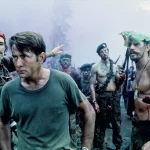Not Guilty by Reason of Insanity, by Scott Nye
First, let’s dispense of one thing – though this shares nearly the same premise as Gareth Evans’ astounding The Raid, released earlier this year, cries of “rip-off” would be woefully unfounded. Dredd actually began filming five months before The Raid, never mind a story process that extends back years prior. What IS true is that placing our hero at the bottom of a high-rise and forcing him to fight his way to the top is an awesome premise no matter how many times you do it, and the similarities between the two films pretty much end there.
Some quick exposition catches us up to this particular dystopia – world’s gone to hell, yada yada yada, people are poor, yada, crime rampant, et cetera, but the key thing to know is that there are these “Judges” who serve as every step of the justice system for this society. They respond to crime reports as a police officer would, but also carry out sentencing on the spot. When we meet Judge Dredd (a wonderfully sparse Karl Urban), he’s responding to one such call, and rather spectacularly (and oh-so-bloodily) dismantles it. Called back to headquarters, he’s introduced to Anderson (Olivia Thirlby), who, despite failing the aptitude test to be a Judge, is given a chance nonetheless because, whatya know, she’s a psychic. Dredd isn’t wild about the idea, but, company man that he is, agrees to take her out for on-the-field assessment.
And that’s when things go wild. Responding to a call at the practically-discarded Peach Tree tower (a 200-story block that provides all the services its destitute citizens could need), Dredd and Anderson are soon trapped by crime-/landlord Ma-Ma (a suitably nasty Lena Headey), who subsequently orders every able-bodied citizen in the building to kill them. What follows plays out as one might expect, with gangs battling heroic fascism, though no less entertaining in spite of either its predictability or social conscience. Dredd is kind of a perfect cinematic superhero, unflappable and seemingly unstoppable. Yet Urban gives him just enough humanity to make us understand that, while he remains composed, he does recognize the gravity of the situation. This is no small acting feat given that Urban wears a huge helmet throughout the entire film, never revealing more than his mouth and chin.
While screenwriter Alex Garland (28 Days Later, Never Let Me Go) gives Dredd a minor arc over the course of the film that culminates in a character-appropriate one-word response, Thirlby is the one asked to carry the real dramatic weight. Going from rookie cop to the worst situation imaginable would perhaps be a little more taxing than she lets on, but this is an action movie after all, and she manages to convey a nice duality between her visible anxiety and the more private command she has over her mental powers. Anytime she utilizes them (which are a little ill-defined, rescuing her and Dredd from some situations while totally neglecting others), the scared look in her eyes vanishes and there’s little question as to who is in control. Given the type of film this is, we are naturally asked to cheer when Anderson overcomes her reticence to carry out the “executioner” end of her job description, and Thirlby’s gung-ho explosion of both capability and willingness sells these moments well.
Director Pete Travis has nothing on his resume that would suggest the kind of highly-stylized work he does here, but it’s really sharp stuff, utilizing handheld in a way that suggest video game aesthetics without feeling cheaply exploitative, but mostly sticking to a more stable camera, one especially well-suited for the 3D element (which is often fun but rarely awe-inspiring). Ma-Ma’s particular crime of choice is peddling a drug called slo-mo, which, as one might guess, causes the brain to process information at 1% its normal speed. It not only makes for some fun plot points (such as the horror of being hurled off a building with that in your system), but more immediately for spectacular visuals. Beyond their eye-catchiness, these shots harken back to Dredd’s comic book origins of using still frames to tell stories. That Travis also inserts, along the way, some particularly canny “world-building” that doesn’t call itself out as such (from the sight of movie theaters within this block to the existence of pay phones in a futuristic environment) is but icing on the cake.
On the whole, Dredd is just a lot of fun to watch, mixing strongly-defined, archetypal characters, a can’t-miss conflict, and freefall morality into a sharply-honed 95-minute concoction. With little time to waste on tiresome exposition or faux-intellectual monologuing, it cuts straight to the heart of why we go to these kind of entertainments – good stories, well told, populated with sharply-defined characters in high-stakes situations. My requirements for such films may be slight, but the infrequency with which they’re met points to how satisfying Dredd really is.





























